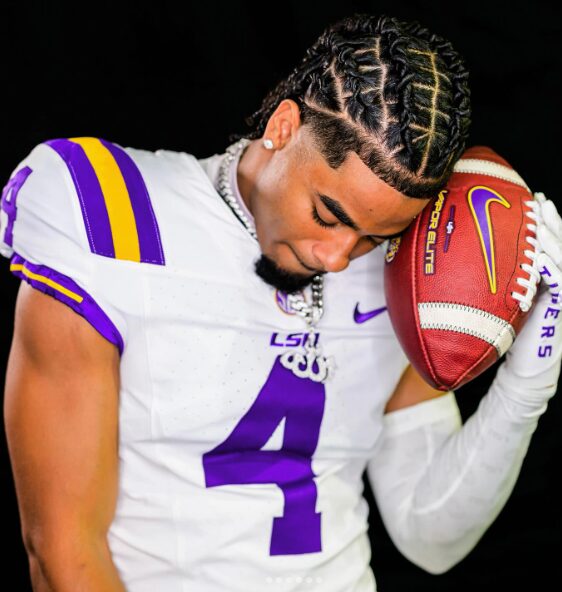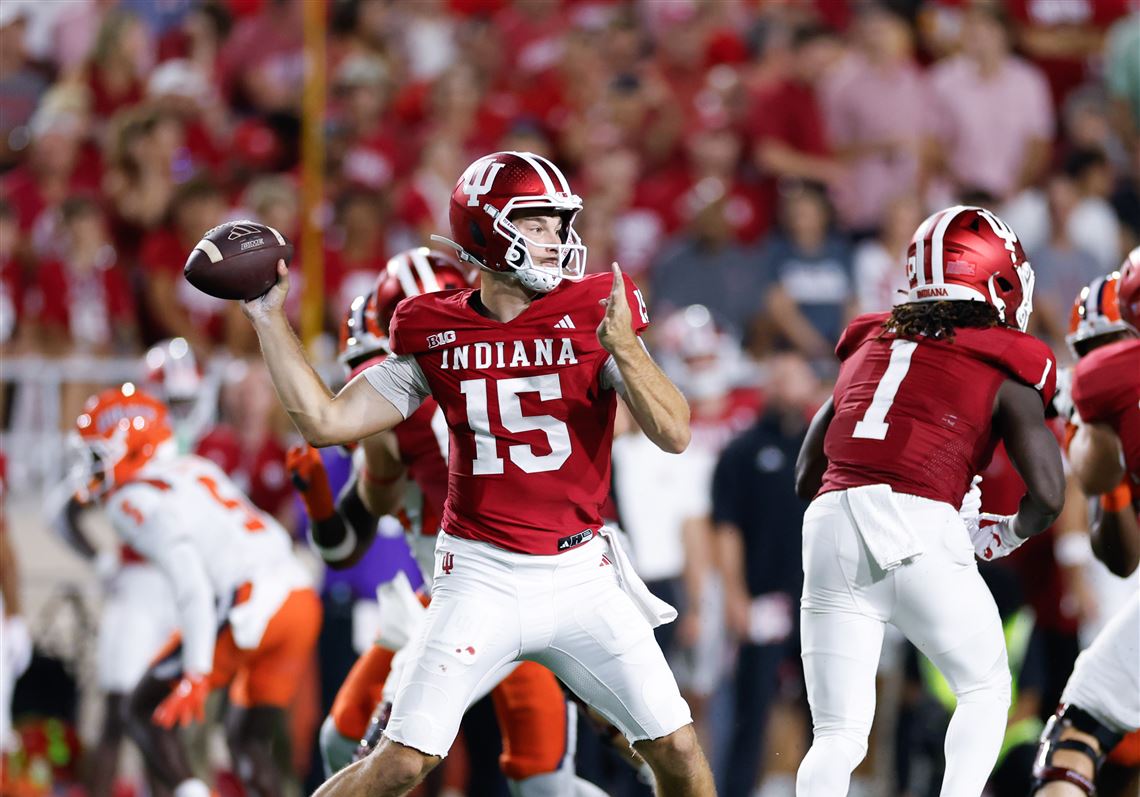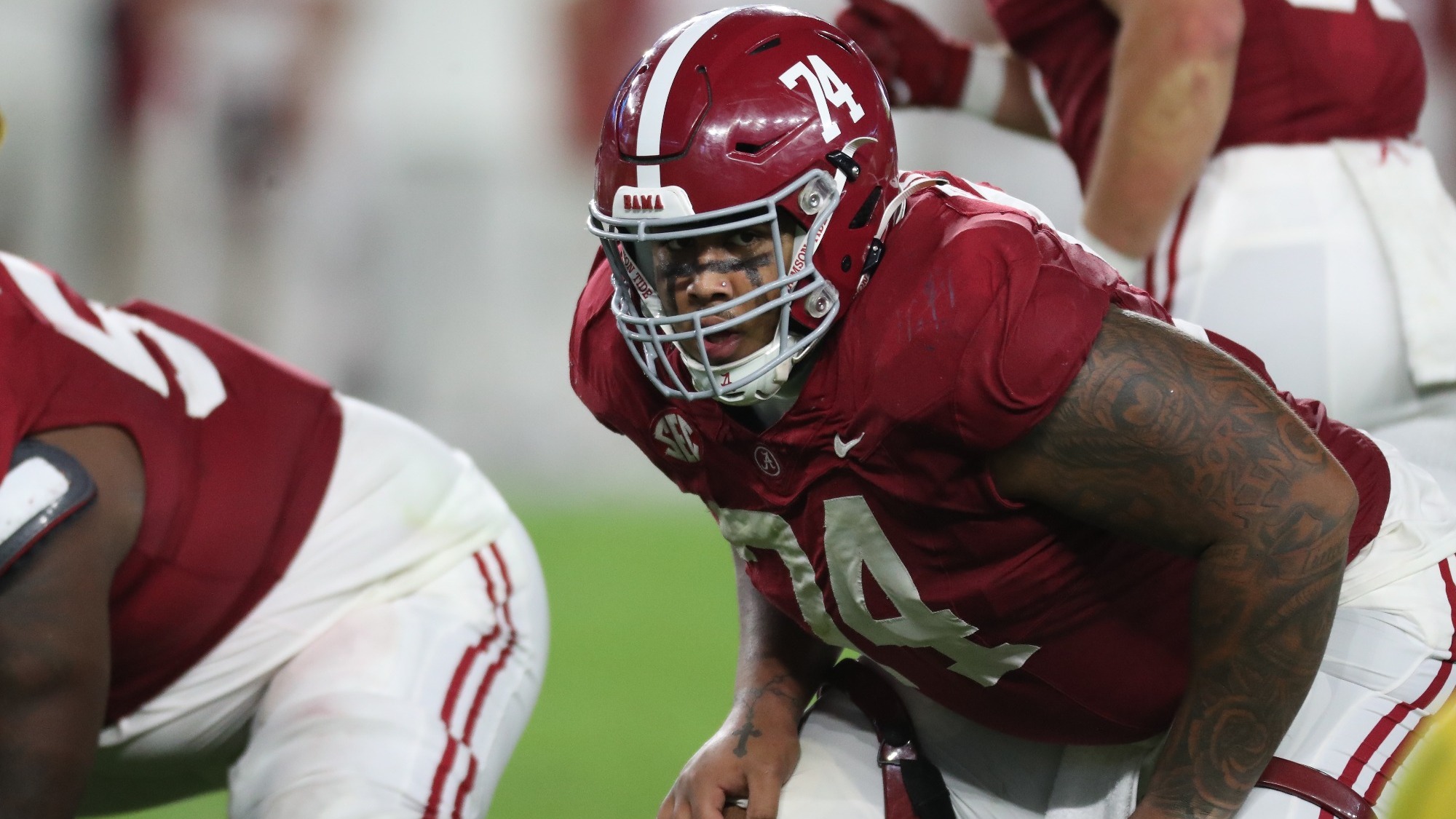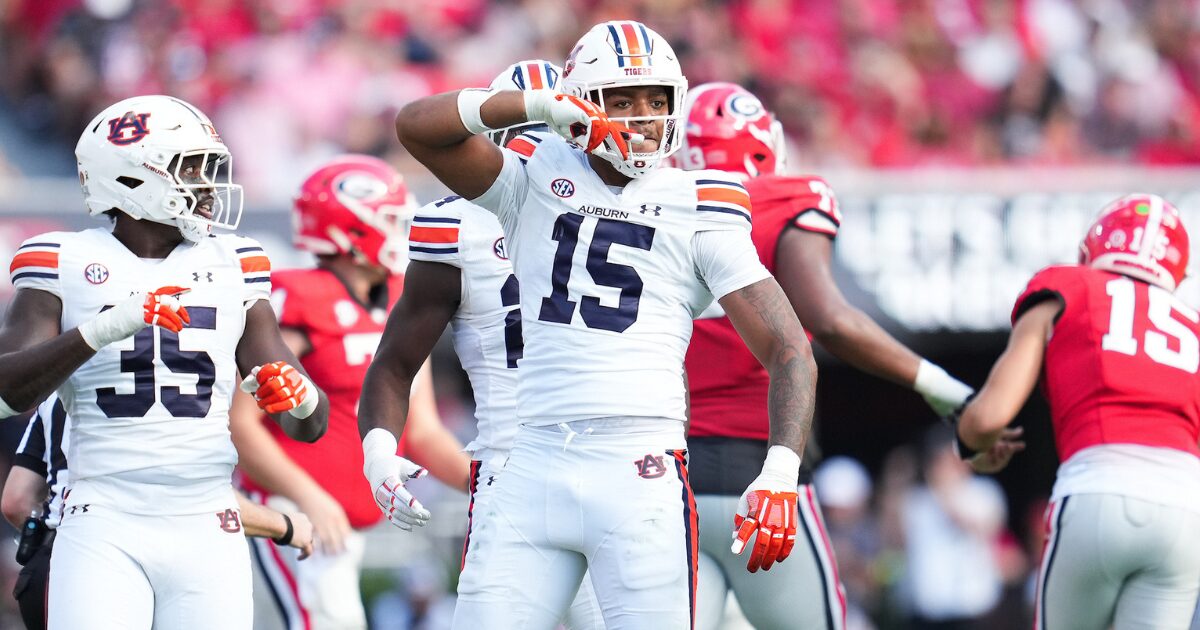By Charlie Campbell.
Send Charlie an e-mail here: [email protected]
Follow Charlie on Twitter @draftcampbell for updates.
This page was last updated March 28, 2022. Follow me @walterfootball for updates.
Position Review: Wide Receivers
Wide Receiver Class
Early-round talent: A
Mid-round: A-
Late-round: B
Overall grade: A-
Merging the 2022 and 2021 prospects
Ja’Marr Chase
Jaylen Waddle
DeVonta Smith
Drake London
Garrett Wilson
Treylon Burks
Jameson Williams
Chris Olave
Ka’Darius Toney
Christian Watson
Jahan Dotson
George Pickens
Rashod Bateman
Elijah Moore
Rondale Moore
D’Wayne Eskridge
Just to be clear this article and series is all my opinion based off my own study and information I’ve gotten from general managers, directors of college scouting, national scouts, area scouts, and NFL coaches who know way more than I do.
Last year’s class of wide receivers was phenomenal. There was excellent talent for the first round of the 2021 NFL Draft, and there were wideouts selected in Rounds 2 and 3 who would have gone a round higher in a typical year. Five receivers went in the first round of the 2021 NFL Draft, and five more went in the second round – a total of 10 in the top-64 selections. Another five more were taken in Round 3, making wide receivers 15% of the selections by the start of Day 3 of the 2021 NFL Draft.
This year’s class has a shot at matching that because the 2022 group is extremely talented and could definitely have 15 wideouts in the top 100. While there is not a wide receiver prospect as good as Ja’Marr Chase, the 2022 class features a lot of superb talents who will provide some second-day steals and other values into Day 3.
If you were to merge the two classes together, Chase would be the top prospect still. Things get more debatable behing him. If Drake London weren’t coming off a season-ending injury, he could be rated higher than Jaylen Waddle and DeVonta Smith. I feel that Garrett Wilson, Treylon Burks, Jameson Williams, and Chris Olave are better prospects than Kadarius Toney, although it might be hard for all four of them to join London in the top 20. Similarly, I think Christian Watson, Jahan Dotson, and George Pickens are better than Rashod Bateman even though those three may not go in the first round like Bateman did. One of the best wide receivers in the NFL in the second half of the 2021 season was Detroit Lions fourth-round pick Amon-Ra St. Brown, so that goes to show that with a talented class, there can be steals well after the first round ends.
Safest Pick: Drake London, USC

Previous Picks:
2021: Ja’Marr Chase
2020: Jerry Jeudy
2019: Deebo Samuel
2018: Christian Kirk
2017: Corey Davis
2016: Will Fuller
2015: Amari Cooper
2014: Sammy Watkins
2013: DeAndre Hopkins
My track record here is pretty good because there hasn’t been a true bust in any of those picks. Hopkins has turned into one of the best players in the NFL regardless of position and is a phenomenal playmaker. Watkins has played well when healthy. Cooper has been inconsistent, but still is a good pro. Fuller has been excellent when healthy. Davis was injured for a lot of his rookie year but came alive in recent seasons. Kirk had a solid start to his career, and Samuel has been sensational. I am proud that I had Samuel rated higher than wide receivers that ahead of him like Marquise Brown and N’Keal Harry. While it would be too early to render judgement on Jeudy, Chase was phenomenal as a rookie.
This was not an easy choice, but I think London translates the best to the NFL because he has a massive frame and is a phenomenal run-after-the-catch receiver. London has mismatch size, quality route-running, solid hands, quality size, and natural receiving ability. I think he could be a mix of Mike Evans and Keenan Allen in the NFL.
Biggest Bust Potential: David Bell, Purdue

Previous Picks:
2020: Elijah Moore
2020: Denzel Mims
2019: N’Keal Harry
2018: Auden Tate
2017: Curtis Samuel
2016: Corey Coleman
2015: Devin Funchess
2014: Kelvin Benjamin
2013: Cordarrelle Patterson
My track record here is pretty good. Obviously, a few more seasons are needed to render any judgment on Moore, but Mims has been a massive disappointment. Harry has been a bust thus far and is on borrowed time to turn it around. Tate was a seventh-round pick, so if he doesn’t pan out, he would not be a true bust given where he was drafted. Samuel is a solid pro, so that bust potential was averted.
Other than Samuel the rest of the group look like a collection of busts. In 2016, I almost went with Laquon Treadwell but chose Coleman. Both of them were huge busts. Funchess had one decent season for Carolina, but overall, he was a disappointment as a second-round pick. Benjamin had a roller coaster career, and he ended up being a bust for Carolina and Buffalo. Patterson was a bust for Minnesota, but he resurrected his career with Atlanta as a running back.
Some analysts are projecting Bell to be an early-round pick in 2022 NFL Draft, which could be a dangerous selection. In the NFL, Bell looks best as a possessional receiver, and I believe he is going to struggle to separate from NFL cornerbacks. I think Bell is more of a backup-caliber athlete without a defining trait like mismatch size or speed.
Wide Receiver Rankings by Attributes
Separation:
NFL prototype: Ja’Marr Chase, Bengals
- Garrett Wilson
- Jameson Williams
- Chris Olave
- Christian Watson
- George Pickens
- Jahan Dotson
- Treylon Burks
- Drake London
Recap: A few wide receivers coaches told WalterFootball.com the ability to separate from coverage is the first trait they looked for in scouting draft prospects. Wilson is the best in this draft class at getting space from defensive backs. He does it with good speed, quick feet, fast route running, and suddenness out of his breaks. Wilson’s separation skill is his best trait.
Williams and Olave are ultra-fast receivers who can separate from defensive backs based on pure foot speed. They are tough for defensive backs to run with and are able to generate space running vertically or crossing the field. Both are dynamic playmakers who are threats to break wide open deep down the field on any given snap.
Both Watson and Pickens are threats to blow by defensive backs on any snap. They are explosive wideouts who can run past defensive backs and are sudden out of their breaks. Watson’s separation skills in 2021 were phenomenal, and he had his way with the Senior Bowl defensive backs. Both Watson and Pickens are going to be a tough coverage assignment for NFL cornerbacks.
Dotson can create separation by using his speed running vertical routes downfield or crossing the middle. While he is not an ultra-fast explosive wide receiver like Wilson or Williams, Dotson definitely has enough quickness to get open.
Burks and London could have issues generating consistent separation from some NFL cornerbacks. Neither one is game-breaking fast, but each has enough quickness to get downfield and can get just enough separation to use their size to make game-changing receptions.
Hands:
NFL prototype: DeAndre Hopkins, Cardinals
- Drake London
- Treylon Burks
- Jahan Dotson
- George Pickens
- Christian Watson
- Garrett Wilson
- Chris Olave
- Jameson Williams
Recap: This is a nice crop of sure-handed receivers. London has phenomenal hands, never dropping a pass. He attacks the football with his hands and really snatches it out of the air. Burks’ hands are effortless; he is natural hands receiver. Dotson has incredible strong hands for a smaller receiver, making highlight-reel catches routinely.
Pickens has very good hands. He is strong to snatch the ball and rip it out of the air. Watson and Wilson have steady hands and are reliable. Olave and Williams don’t have bad hands, but they drop some passes. Their drop rates were not anything alarming, but each has room for improvement in the NFL.
Deep Speed:
NFL prototype: Tyreek Hill, Dolphins
- Jameson Williams
- Garrett Wilson
- Chris Olave
- Christian Watson
- George Pickens
- Jahan Dotson
- Treylon Burks
- Drake London
Recap: There a number of receivers in this group who have the ability to stretch the field vertically. Williams and Wilson are legit deep-threat receivers with dangerous speed. They are very fast wideouts who can take the top off of a defense. Deep speed is one of the special dimensions each brings to the table.
Olave and Watson are dangerous deep-threat receivers for the NFL, and they both showed that over the course of their college careers. At the 2022 NFL Scouting Combine, both of them ran excellent times, illustrating their explosive speed with first-step quickness and a second gear to accelerate away from defensive backs.
Pickens and Dotson are dangerous at running verticals, where they have build up speed and quickly runn straight down the field.
Burks is a not a deep-speed receiver who burns defenses with pure explosion, but he does make some plays downfield. He has quickness and is adept at making difficult catches downfield with defenders close by him. London is not a burner for the next level, but he has enough quickness to get downfield and then use his mismatch size along the sideline. That makes him a threat to produce some big plays downfield with catches over defensive backs.
Route-Running:
NFL prototype: Stefon Diggs, Bills
- Garrett Wilson
- Chris Olave
- Jameson Williams
- Christian Watson
- Jahan Dotson
- Drake London
- Treylon Burks
- George Pickens
Recap: Route-running is a critical part of gaining separation in the NFL. Receivers who get sloppy in their routes have a hard time getting open. Extra steps allow defensive backs to maintain coverage or more time to recover. This group of eight wideouts all are quality route-runners, but one of the best route-runners in this draft class is Kentucky wide receiver Wan’Dale Robinson, who doesn’t make this grouping.
Wilson is a phenomenal route-runner and is very polished entering the NFL. He is smooth and sudden in and out of his breaks with speed; he never takes extra steps; and his route-running often produces immediate separation from cornerbacks. When route-running is taught to young wide receivers at the college level, tape of Wilsons’ route-running at Ohio State could serve as an example.
The Ohio State coaching can be seen in Olave as well, with him being very polished receiver whose route-running is advanced. Olave has precise feet, an ability to avoid wasted steps, and explosion out of breaks. Olave can consistently generate separation via his route-running.
Williams and Watson are plus-level route-runners. Williams is a smooth route-runner who does well at running the slants, crosses, outs, and dig routes. With his explosive speed, Williams is a serious weason. Watson’s speed allows him to quickly get open in the short to intermediate part of the field. He does a nice job of running downfield routes and has suddenness out of his breaks.
Dotson shows quality technique as a route-runner, and he has been coached up well. He doesn’t take false steps and runs crisp routes. London is quick enough, and his size allows him to present a good target on short to intermediate routes. For a big receiver, London is a better route-runner than one expects, and he is smooth out of breaks.
Burks and Pickens are both quality route-runners, but each could use some development in running a wider variety of routes for the next level.
Yards After the Catch:
NFL prototype: Mike Evans, Buccaneers
- Drake London
- Treylon Burks
- Garrett Wilson
- Christian Watson
- Jameson Williams
- Chris Olave
- Jahan Dotson
- George Pickens
Recap: The ability to turn a short reception into a big gain can make a receiver elite. Among the eight receivers above, all of them have some run-after-the-catch ability, and I wouldn’t say there is one that is really lacking.
While London is not the fastest of the group, he is the most dynamic, and in the NFL, the cornerbacks are too fast just hope to run away from the defense on catches. Perhaps London’s most special quality is racking up yards after the catch. After making the reception, London gets North-South and charges through the secondary like a man possessed. He will push through defenders, and his ability to break tackles and pick up yards after contact are truly rare for a wide receiver. London uses his power to push defenders away and his big body to go through them, while also showing excellent balance to maintain his feet. London is such a fighter; hr never quits on a play. Often it takes a group of defenders to get him to the ground.
Burks is very dangerous with the ball in his hands. He uses his well-built frame to break tackles and is very difficult for a lot of defensive backs to get to the ground. His strength to run through their hands makes it hard for them to get a hold of him. While he isn’t super elusive and is more straight line, Burks does have the feet to dodge some tacklers in the open field. Burks has excellent yards-after-the-catch potential for the next level, and he could be a great fit in a West Coast offense.
After the catch, Wilson is excellent. He is very elusive in the open field, possessing phenomenal feet to dodge tacklers, stop/start, and cut through the secondary. Wilson’s yards-after-the-catch skills in combination with his speed make him a distinct danger to turn a short reception into a long gain.
With his size and speed, Watson is a dangerous yards-after-the-catch receiver, and he showed that at the Senior Bowl as well. On end arounds and short receptions, Watson shows good vision and cutting ability to weave his way through the defense and a burst to accelerate into the open field.
Williams, Olave and Pickens are more straight line receivers who try to win with speed when they cut and explode past defenders. After the catch, Dotson is a good runner who shows some elusiveness, but he is undersized and not ultra-fast, so he may not be a dynamic yards-after-the-catch receiver in the NFL.
Red Zone:
NFL prototype: Davante Adams, Raiders
- Drake London
- Treylon Burks
- Christian Watson
- Chris Olave
- Garrett Wilson
- George Pickens
- Jameson Williams
- Jahan Dotson
Recap: This was a tough category to rank because so many of the receivers were excellent point producers in college. London projects to being the best red-zone weapon of this group because he is the biggest of them and is phenomenal at winning 50-50 passes. On top of being able to sky over defenders for scores, London is so dynamic with his yards after the catch that he can make easy reception and then use his running ability to go through defenders to cross the goal line. Beyond his receiving ability, London is a tough blocker who will help his team in the red zone by taking on defensive backs.
Burks is very good in the red zone, recording 18 touchdowns over the past two seasons. He is dangerous red-zone threat given his run-after-the-catch talent, leaping ability, and skill at winning 50-50 passes.
Watson notched seven touchdowns last year, and he was superb in the red-zone work at the Senior Bowl. With his mismatch size and the speed to get open quickly, Watson could be a dynamic red-zone producer as a pro.
Olave set Ohio State’s career record for touchdown catches in 2021, so obviously he can get the job down in the red zone. With enough size to make leaping grabs, Olave is a dangerous threat because he is so fast and has the ability to uncover in the condensed field.
Over the past two seasons. Wilson notched 18 touchdowns, which is a ridiculous total when you consider the 2020 season was shortened to a half season because of COVID-19 and that Wilson missed some time in 2021 with an injury. He gets open in a blur and has enough size to win. Wilson will be an asset in the red zone in the NFL.
Pickens, Williams and Dotson all have red-zone ability. Pickens can make leaping grabs easily, while Williams and Dotson can use their speed to get open.
NFL Picks - Jan. 12
2026 NFL Mock Draft - Jan. 7
NFL Power Rankings - Jan. 5
Fantasy Football Rankings - Sept. 1




